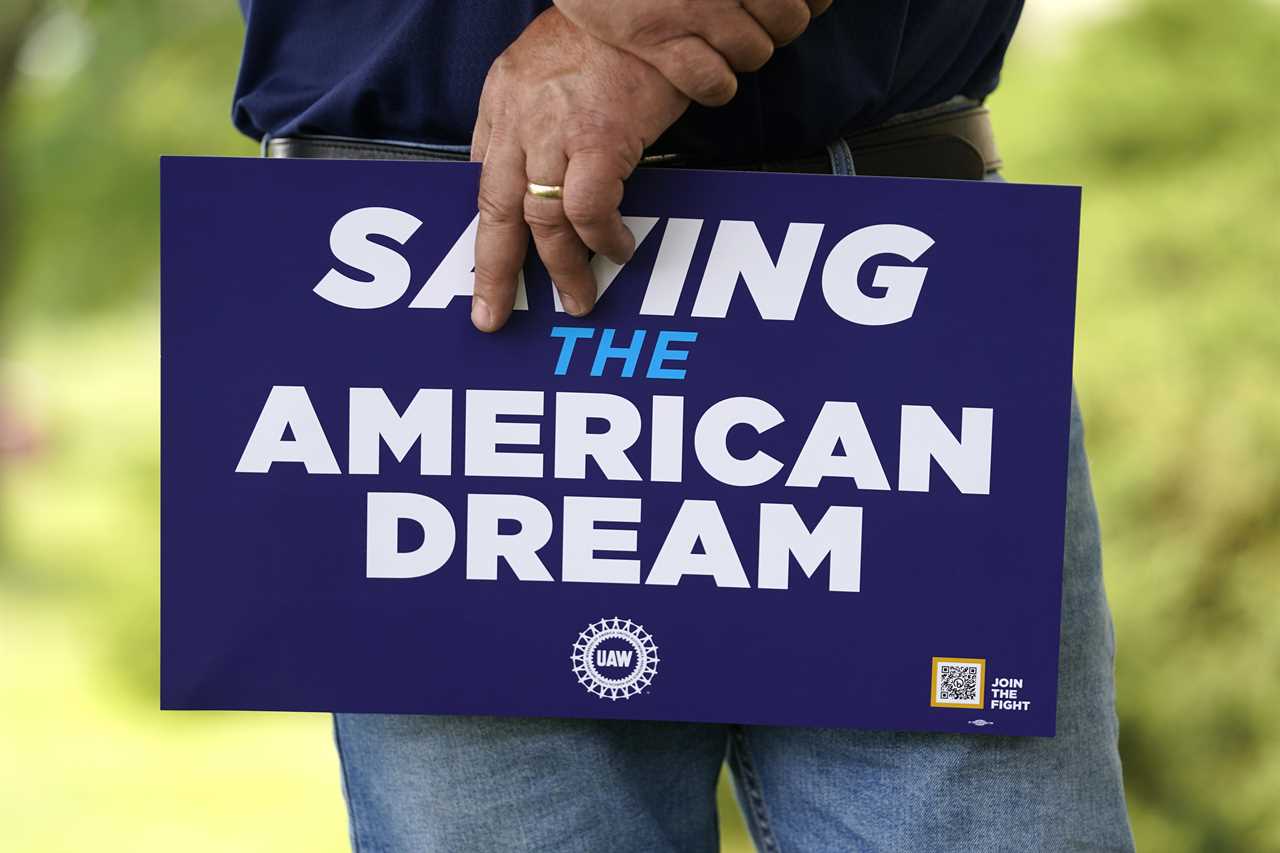
As the United Auto Workers braces for a potentially historic strike in September, the union has taken a justifiably hard line in its negotiations with America’s Big Three automakers. The companies’ outsized profits and the more than ample reward structures for top executives at General Motors, Ford and Stellantis underscore the fruits of a period of industry prosperity from which 350,000 unionized auto workers have largely been excluded.
Why, for instance, the union asked, has GM CEO Mary Barra seen huge raises — earning $29 million in 2022 and over $200 million over the last nine years — while many auto workers still toil under a draconian two-tier wage system that pays new hires substantially less than old ones, inaugurated following GM’s 2009 bankruptcy and massive Washington bailout?
A further rational basis for militancy can be found in the union’s mounting alarm at the unfolding of another ominous two-tier system, wherein the many new plants needed to supply an anticipated gusher of battery electric vehicles are now being sited by the Big Three not on their unionized home turfs, but in new plants rising in non-union states farther South. Vague assurances of the car makers’ abiding respect for their union partners notwithstanding, lower wages, fewer protections for workers and diminished retirement security number are among the likely results.
But if the union is readying itself for a no holds barred strike, why is it also doing the industry’s dirty work? On one key issue, the UAW has aligned itself closely with the executives it otherwise denounces: resistance to the crucially needed clean energy transition. It’s an embarrassing move that highlights the union’s short-term thinking, not just in light of the climate crisis, but because of the union’s own environmentalist roots and clear understanding that an electric future is coming.
Already, executives have been quietly endeavoring to solidify an arbitrary dichotomy of electric batteries vs internal combustion engines (ICE) by echoing a key strategy from Tesla. Elon Musk built his EV juggernaut in part by lobbying state houses across the nation for permission to sidestep state dealer franchise laws that threatened to thwart its dealer-free, direct-to-consumer sales model, arguing that electric cars were somehow different than gasoline-powered ones. The big American automakers have floated to analysts the same approach for their electric vehicles, hoping to gin Tesla-crazed markets and add the luster of extra-profitability — and in doing so, permanently recast relations with their dealers and, now, it seems, their unions.

The union’s ambivalence toward a clean energy future was made strikingly clear when the historically pro-Democrat UAW refused to endorse, for now, President Joe Biden’s re-election bid. The decision came after the White House’s announcement of a $9.2 billion Department of Energy loan guarantee to Ford Motor Co. to help build a massive battery plant, BlueOval City, in Stanton, Tennessee, a so-called right-to-work state. The loan contains no language requiring Ford or its joint venture partner, South Korea’s SK On, a unit of a Korean chemical company, to ensure union involvement. Biden’s signature Inflation Reduction Act, by contrast, was accompanied by specific promises to boost union job creation.
UAW officials worry, not without cause, that Ford, GM and Stellantis will use electrification and joint ventures like Ford’s to do an end run around the union that’s represented Ford’s workers since 1941 — just as parts suppliers now make parts the companies once manufactured themselves, with lower-paid, non-union workers. The jobs in Stanton will be “low road,” UAW president Shawn Fain predicted; Ford responded that wages paid will be “competitive,” which in a right-to-work state promises to be less encouraging than it’s meant to sound.
For the record, while refusing to endorse Biden as yet, Fain has told his union that another Donald Trump presidency would be “a disaster.” Yet Trump himself has seen enough of an opening that he was moved to make a 3-minute campaign video where he inveighed with characteristic eloquence, “I hope United Auto Workers is listening to this, because I think you better endorse Trump because I’m going to grow your business and they are destroying your business. They are absolutely destroying your business.”
Though it has genuine reason for concern over a net loss of jobs going forward — electric cars have fewer moving parts and require fewer workers to build than cars with the traditional internal combustion engine — the union claims it antipathy here is towards the non-union aspect of the new battery and EV factories not the technology itself.
“We have been absolutely clear that the switch to electric engine jobs, battery production and other EV manufacturing cannot become a race to the bottom,” Fain said in response to the DOE-Ford deal. “Not only is the federal government not using its power to turn the tide — they’re actively funding the race to the bottom with billions in public money.”
It is a little remembered fact that in 1970, the very first Earth Day was sponsored and funded in part by the UAW and its seminal leader, Walter P. Reuther. Despite the union’s symbiotic relationship with this heavy industry, Reuther had pushed the UAW to actively engage in efforts to curb water and air pollution, as well as promote what we today might call sustainability.
Somewhere along the way, however, the UAW’s attachment to environmentalism dwindled. That became obvious during an interview I conducted in the late 1990s with then-UAW president Steve Yokich, undertaken in Detroit for the late lamented Automobile Magazine. The conversation turned suddenly sour when I asked why the union didn’t say anything about the Detroit automakers’ obvious intention to stop building passenger cars — abandoning what was then still a large swathe of the market in favor of the bigger, thirstier and more dangerous sport utility vehicles. That was the American industry’s easiest ticket to short-term profit and required the least engineering and investment, but it was bad for the environment and the industry’s long-term competitiveness. What followed was the harshest tongue-lashing any interview subject has ever directed my way. He wouldn’t hear it, the now-deceased Yokich screeched, and the interview quickly ended.
Sadly, this same unspoken but primary allegiance to the industry’s own retrograde strategies resurfaced again last month when the UAW implored the Biden administration to dramatically water down proposed vehicle emissions rulings that would effectively require battery power for two-thirds of all new vehicles by 2032. Indeed, a trade association representing the American brands had already deemed the Biden proposals “neither reasonable nor achievable,” while Toyota Motor called the EPA proposal “extreme and outside historical norms.” Well, of course they are, one might point out, as are the extreme weather patterns and other devastating effects of excessive carbon emissions currently being felt.
Nonetheless, the regulatory proposals should be altered, the union urged the Biden administration, to “better reflect the feasibility of compliance so that the projected adoption of (zero emission vehicles) is set to feasible levels, increases stringency more gradually, and occurs over a greater period of time.”
Once again, the UAW has embraced the industry’s viewpoint that tough new rules will cost jobs. Perhaps because it’s an easier move to make than the long, difficult work needed to organize in some of the most union-resistant states in the country, a task that the Biden administration, despite its overt, pro-union statements, has shied away from.
The idea that regulatory action aimed at limiting automotive emissions should be slowed down, if not eliminated entirely, is as old as the hydrogen bomb. From the late 1940s onward, American industry has opposed or sought to water down every legislative or regulatory environmental initiative that sought to curb vehicle pollution, arguing untruthfully that meeting stricter standards would be technically impossible or bankrupt it. The Clean Air Act of 1970, Henry Ford II maintained, would put the Ford Motor Company out of business, while then-GM Chair Ed Cole took the more reasonable position, saying it would only result in the loss of half a million jobs. The Act passed anyway — it was clearly a different time — and none of the dire prophesies came to pass.
Returning to this century, at the time of its 2009 bailout, the industry tripped over itself making promises about its commitment to improving fuel economy and turning over a new green page in return for taking taxpayer dollars. What happened? The industry played the Obama administration, securing devious cut-outs in regulations that enabled SUV and pickup sales to proliferate beyond one’s wildest imagination. Then GM killed its hybrid Chevrolet Volt (and more recently its all-electric Bolt) and Ford stopped building passenger cars almost entirely; meanwhile, Stellantis’ American brands Chrysler, Jeep and Ram have yet to sell more than a handful of all-electric cars.
No one said the EV conversion was going to be easy, but increasingly the industry — which was only recently making bold, albeit suspiciously non-binding, promises to wean itself off gasoline — is once again making heavy investment in plants that would build evermore gas-guzzling SUVs and pickups while busily lobbying to delay the widespread adoption of electric vehicles.
And into this business-as-usual mess wades the UAW, about to strike the industry that feeds it even as it beclowns itself by inadvertently buying into the same gas-versus-electric dichotomy that in another context it objects to so strongly.
In its understandable desire to protect its workers’ jobs, the union has allowed itself to be cynically weaponized by the industry to promote its anti-green agenda, tying the full-fat wages its members earn in unionized truck plants in the north — ones that really ought to be getting converted to EV production, stat — to a lobbying effort that would undermine a more rapid electric transition and threatens ultimately to hurt its members. For assuming the promised widespread conversion to electric vehicles comes to pass and the EV/ICE dichotomy has been allowed to proceed, all union jobs will eventually be lost.
“EPA must recognize,” the union insisted in its plea to ease the proposed regulations, “that the current domestic auto assembly footprint is heavily weighted towards the profitable light-duty truck and SUVs that are tasked with funding the EV transition.”
Inarguably true, but it wouldn’t have been so except for industry recalcitrance. It’s a fair bet it won’t be otherwise until not just the government but also the union that serves the American industry demands better. The old jobs vs. the environment lie just won’t do.
----------------------------------------
By: Jamie Lincoln Kitman
Title: Opinion | Why a Big Union Is Snubbing Biden, Doing Industry’s Dirty Work and Creating an Opening for Trump
Sourced From: www.politico.com/news/magazine/2023/08/30/united-auto-workers-clean-energy-00113387
Published Date: Wed, 30 Aug 2023 03:30:00 EST






